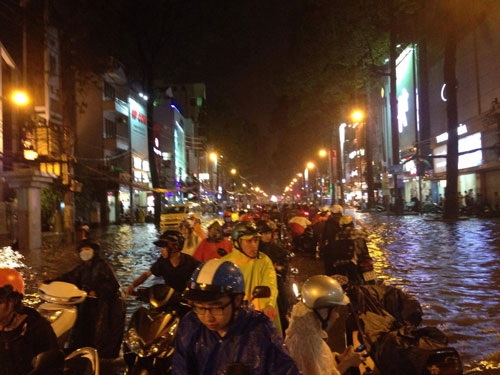 Environment
Environment

The need to accelerate flood-prevention projects has become more urgent than ever as HCM City mobilised workers and pumps to remove water from flooded streets following a historic downpour on Monday evening that inundated the city.
 |
| People wade through an inundated 3/2 Street in HCM City’s District 10 following a historic downpour that severely flooded the city on Monday evening. Photo Ngô Nhật Hoàng |
HCM CITY — The need to accelerate flood-prevention projects has become more urgent than ever as HCM City mobilised workers and pumps to remove water from flooded streets following a historic downpour on Monday evening that inundated the city.
Traffic was thrown completely out of gear on many major streets as people hurried home after work during the three-hour downpour.
Many motorbikes broke down and others were stuck for very long in the gridlock caused by the flooding.
More than 175mm of rain fell after starting at around 4pm, the highest amount recorded in a single downpour in recent years, according to city authorities.
Worse still, as the floodwaters eddied, many motorbike riders were thrown off by the resultant strong currents.
The Pasteur-Hàm Nghi junction in District 1 and Nguyễn Hữu Cảnh and Nguyễn Duy Trinh streets in District 2 were submerged in half a metre of water.
Elsewhere, Phan Thúc Duyên, Phan Đình Giót, Nguyễn Hồng Đào streets in Tân Bình Dictrict, Lê Đức Thọ, Quang Trung in Gò Vấp, Phạm Hùng in District 8 and Huỳnh Tấn Phát in District 7 were gridlocked due to the flooding.
Basements, and even ground floors in some places, were inundated in many parts of the city.
A video posted on Facebook on Monday evening showed water leaking into the iconic Bitexco Financial Tower, the city’s highest building.
Even relatively higher areas like Nam Kỳ Khởi Nghĩa and Trần Hưng Đạo streets in District 1 were inundated.
Nguyễn Thị Ánh Xuân, 27, an administration staff at Global Source Company in District 1, told Việt Nam News she struggled to return home in District 1 by motorbike.
“I have never seen such heavy rains like this before. The street to my house was completely flooded and congested. My rented room was also flooded.”
“Some neighbours had to rent hotel rooms because they reached home too late to clean up.”
More than 1,000 motorbikes were under water at a parking lot on Nguyễn Siêu Street in District 1. Their owners had to wait for hours for the waters to ebb before they could retrieve their vehicles. They then had to head straight to mechanics’ shops since the engines were flooded.
It’s now the peak rainy season in southern Việt Nam and heavy downpours are expected to continue until November, according to the Southern Region Hydro-meteorological Station.
Many flights affected
The deluge affected many domestic and international flights arriving at Tân Sơn Nhất International Airport in Tân Bình District.
At least 12 flights had to be diverted to other airports, according to the airport authorities.
The downpour reduced visibility to 600 metres in the country’s busiest airport, forcing many flights to delay take-off and landing, according to the Southern Air Traffic Management Centre.
The rain also flooded part of the aprons, but not as seriously as in the past thanks to the city’s recent efforts to improve drainage canal around the airport, according to Đặng Tuấn Tú, director of Tân Sơn Nhất.
Vietnam Airlines announced that flights arriving from Melbourne, Hong Kong, Guangzhou, and Hà Nội were forced to land in other airports nearby.
Three Vietjet Air flights en route from Yangon (Myanmar), Hà Nội and Đà Nẵng were diverted to Cam Ranh International Airport in the central province of Khánh Hoà.
Many flights leaving HCM City were also delayed by rain, according to the airport authorities.
Trường Sơn Street in Tân Bình District, which leads to the airport, was submerged and horribly congested.
No figures are available for the losses caused by the rains. However, almost all flooded areas are back to normal today, according to city authorities.
Flood-prevention project
HCM City is carrying out a flood control project in 19 out of 24 districts involving an area of 570 square kilometres and a population of 6.5 million, according to the Steering Centre of the Urban Flood Control Programme (SCFC).
The project is expected to control flooding and mitigate the effects of climate change.
It is funded by loans from the World Bank’s International Bank for Reconstruction and Development and funds from the city, according to the SCFC.
It will see the construction of six culverts with a width of 40-160 metres and an embankment of nearly 7.8 kilometres along the Sài Gòn River.
Three pumping stations with a capacity of 12-48 cubic metres per second and 25 small drains will also be built, according to the city administration.
Sluices and tide control locks will be installed on the Nước Lên Canal and Vàm Thuật River.
In addition, 32.7 kilometres of dams will be built on the Tham Lương, Bến Cát, and Nước Lên Canals, and nine kilometres of drainage in Gò Vấp District.
Water channels in Tân Bình and Gò Vấp districts will be upgraded.
The project will require more than VNĐ9.5 trillion ($426.11 million), with VNĐ8.761 trillion ($392.9 million) coming from ODA and the rest from the city, according to SCFC.
Nguyễn Tâm Tiến, general director of Trung Nam Investment, Construction Joint-Stock Co, said a downpour on August 26 dumped 150mm of rain in two hours. The city’s sewer system can handle no more than 100mm of rain over three hours, he said.
“The flood control project will help effectively resolve flooding caused by high tides.”
At a recent meeting city authorities said they would earmark more than VNĐ156 trillion ($7 billion) for anti-flooding projects over the next five years. — VNS




